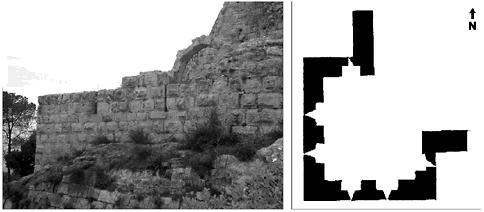Muslim Fortresses in the Levant: Between Crusaders and Mongols (36 page)
Read Muslim Fortresses in the Levant: Between Crusaders and Mongols Online
Authors: Kate Raphael
Tags: #Arts & Photography, #Architecture, #Buildings, #History, #Middle East, #Egypt, #Politics & Social Sciences, #Social Sciences, #Human Geography, #Building Types & Styles, #World, #Medieval, #Humanities


Figure 1.21 , archers’ galleries along the southwestern corner
, archers’ galleries along the southwestern corner
The only tower that still stands at full height is at the southeast corner (
Figure 1.22
). It has one floor, an open central hall with six spacious arrow-loops stemming off it. The only evidence of the existence of galleries is in the plan drawn y the Franciscans.
Paul Chevedden, who had conducted an extensive research on siege machines and fortifications during the Ayyubid period, reached the conclusion that “ drastically changed the construction of defensive circuits and the building of towers, which, became larger, higher, thicker and more closely spaced.”
drastically changed the construction of defensive circuits and the building of towers, which, became larger, higher, thicker and more closely spaced.”
190
This change, says Chevedden, occurred due to the introduction of the large counterweight trebuchet into the defense of fortresses.
191
Most of the towers described above are very modest in size. However, each fortress has one tower that is significantly larger than the rest. They ere all capable of carrying a
manjanīq
, although it was probably not a large counterweight trebuchet.
Chevedden’s conclusions were drawn mainly from the survey of towers in urban fortresses such as Damascus, Aleppo and Bosra. Although towers in rural and frontier fortresses grew and doubled in dimensions their average size was still smaller than that of the massive urban towers. In addition, they were sparsely placed along the

Figure 1.22
Mount Tabor, the tower at the southeast corner
Table 1.4
Tower measurements
Name of fortress | Size in meters |
| 4 × 3, 4 × 4, 5 × 5 |
| 5, 7 (diameters of round tower) |
| 8 × 8, 9 × 9, 11 × 11, 15 × 15 |
| 22 × 24 (L-shaped tower) |
Mount Tabor 1211 | 5 × 3.75, 8.25 × 7.5, 11.25 × 11.25, 12.25 × 15, 12.5 × 17.5 |
| 10 × 10, 19 × 12.5 |
| 14 × 15, 20 × 8, 18 × 22 |
curtain walls, as can be seen in both Mount Tabor and where the distances between the towers run from 75 to 150m.
where the distances between the towers run from 75 to 150m.
To summarize the observations derived from archaeological surveys and measurements taken at four Ayyubid fortresses requires a great deal of caution. The four fortresses do not give a clear-cut answer as to one particular direction of development towards which Ayyubid fortresses were moving. It is almost impossible to isolate particular elements, dimensions or ideas that are shared equally by all four fortresses. It is important to remember that the Ayyubid period of construction was relatively short when compared to that of the Crusaders, which went on for almost two centuries. However, some conclusions may be reached and a few interesting ideas suggested concerning the general Ayyubid strategy, which differed greatly from that of the Franks and the Mamluks.


